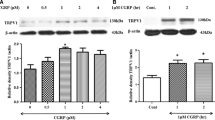Summary
In the superfused isolated rat urinary bladder, capsaicin as well as electrical field stimulation evoked the release of calcitonin gene-related peptide-like immunoreactivity (CGRP-IR). Carbonyl cyanide p-trichloromethoxyphenylhydrazone (CCCP, threshold 2 μM) reduced both, the capsaicin- and the electrical field stimulation-evoked release of CGRP-IR while a low concentration of Ruthenium Red (RR, 0.6 μM and 2 μM) selectively attenuated the capsaicin-evoked release of CGRP-IR but did not influence the effect of electrical field stimulation. 20 μM RR nearly abolished the capsaicin-evoked release, but also attenuated the effect of electrical field stimulation.
In the isolated guinea-pig bronchus, electrical field stimulation and capsaicin induced non-cholinergic contractions which are known to be caused by tachykinin release from afferent nerve terminals. CCCP (0.6 μM) only reduced the response to field stimulation; a ten-fold higher concentration of CCCP attenuated field stimulation as well as capsaicin-induced contractions. This is in contrast to the reported selective inhibition of capsaic-ininduced contractions by RR.
The present data demonstrate that CCCP generally inhibits evoked neuropeptide release, regardless of the kind of stimulation used while low concentrations of RR preferentially inhibit capsaicin-evoked neuropeptide release.
Similar content being viewed by others
References
Adams DJ, Takeda K, Umbach JA (1985) Inhibitors of calcium buffering depress evoked transmitter release at the squid giant synapse. J Physiol (Lond) 369:145–149
Alnaes E, Rahamimoff R (1975) On the role of mitochondria in transmitter release from motor nerve terminals. J Physiol (Lond) 248:285–306
Amann R, Donnerer J, Lembeck F (1989a) Ruthenium red selectively inhibits capsaicin-induced release of calcitonin gene-related peptide from the isolated perfused guinea-pig lung. Neurosci Lett 101:311–315
Amann R, Donnerer J, Lembeck F (1989b) Capsaicin-induced stimulation of polymodal nociceptors is antagonized by Ruthenium red independently of extracellular calcium. Neuroscience 32:255–259
Bernath S, Vizi ES (1987) Inhibitory effect of ionized free calcium enhanced by ruthenium red and m-chlorocarbonylcyanide phenyl hydrazon on the evoked release of acetylcholine. Biochem Pharmacol 38:179–226
Chahl LA (1989) The effects off ruthenium red on the responses of guinea-pig ileum to capsaicin. Eur J Pharmacol 169:241–247
Gamse R, Molnar A, Lembeck F (1979) Substance P release from spinal cord by capsaicin. Life Sci 25:629–636
Gulbekian S, Merighi A, Wharton J, Varndell IM, Polak JM (1986) Ultrastructural evidence for the coexistence of calcitonin gene-related peptide and substance P in secretory vesicles of peripheral nerves in the guinea-pig. J Neurocytol 15:535–542
Helke JC, Jacobowitz DM, Thoa NB (1981) Capsaicin and potassium evoked substance P release from the nucleus tractus solitarius and spinal trigeminal nucleus in vitro. Life Sci 29:1779–1785
Lundberg JM, Saria A (1982) Bronchial smooth muscle contraction induced by stimulation of capsaicin sensitive sensory neurons. Acta Physiol Scand 116:473–476
Maggi CA, Patacchini R, Giuliani S, Santicioli P, Meli A (1988a) Evidence for two independent modes of activation of the “efferent” function mediated by peripheral terminals of capsaicin-sensitive sensory neurons by the use of omega conotoxin GVIA, a peptide modulator of neuronal calcium channels. Eur J Pharmacol 156:367–375
Maggi CA, Santicioli P, Geppetti P, Parlani M, Astolfi M, Pradeles P, Patacchini R, Meli A (1988b) The antagonism induced by Ruthenium red of the actions of capsaicin on the peripheral terminals of sensory neurons: further studies. Eur J Pharmacol 154:1–10
Maggi CA, Patacchini R, Santicioli P, Giuliani S, DelBianco E, Meli A (1989a) The “efferent” function of capsaicin-sensitive nerves: Ruthenium Red discriminates between different modes of activation. Eur J Pharmacol 170:167–177
Maggi CA, Santicioli P, Geppetti P, Parlani M, Astolfi M, DelBianco E, Patacchini R, Giuliani S, Meli A (1989b) The effect of calcium free medium and nifedipine on the release of substance P-like immunoreactivity and contractions induced by capsaicin in the isolated guinea-pig bladder. Gen Pharmacol 40:445–456
Marsh SJ, Stansfield CE, Brown DA, Davey R, McCarthy D (1987) The mechanism of action of capsaicin on sensory C-type neurons and their axons in vitro. Neuroscience 23:275–289
Merighi A, Polak JM, Gibson SJ, Gulbekian S, Valentino KL, Peirone SM (1988) Ultrastructural studies on calcitonin gene-related peptide-, tachykinin- and somatostatin-immunoreactive neurones in rat dorsal root ganglia: Evidence for colocalization of different peptides in single secretory granules. Cell Tissue Res 254:101–109
Su HC, Wharton J, Polak JM, Mulderry PK, Ghatei MA, Gibson SJ, Terenghi G, Morrison JFB, Ballesta J, Bloom SR (1986) Calcitonin gene-related peptide immunoreactivity in afferent neurons supplying the urinary tract: Combined retrograde tracing and immunohistochemistry. Neuroscience 18:727–747
Szolcsányi J, Barthó L (1982) Capsaicin-sensitive noncholinergic excitatory innervation of the guinea-pig tracheobronchial smooth muscle. Neurosci Lett 34:247–251
Tapia R, Meza-Ruiz G (1977) Inhibition by ruthenium red of the calcium-dependent release of 3H-GABA in synaptosomal fractions. Brain Res 126:160–166
Wood JN, Winter J, James JF, Rang HP, Yeats J, Bevan S (1988) Capsaicin-induced ion fluxes in dorsal root ganglionic cells in culture. J Neurosci 8:3208–3220
Author information
Authors and Affiliations
Additional information
Send offprint requests to: R. Amann at the above address
Rights and permissions
About this article
Cite this article
Amann, R., Maggi, C.A., Giuliani, S. et al. Effects of carbonyl cyanide p-trichloromethoxyphenylhydrazone (CCCP) and of ruthenium red (RR) on capsaicin-evoked neuropeptide release from peripheral terminals of primary afferent neurones. Naunyn-Schmiedeberg's Arch Pharmacol 341, 534–537 (1990). https://doi.org/10.1007/BF00171733
Received:
Accepted:
Issue Date:
DOI: https://doi.org/10.1007/BF00171733




